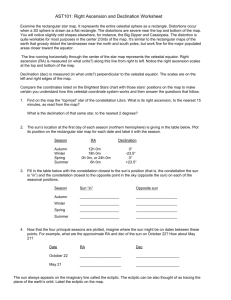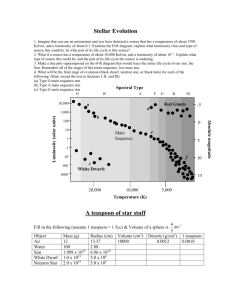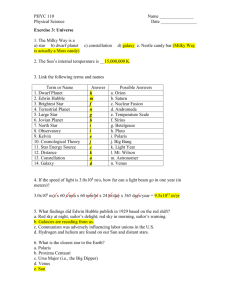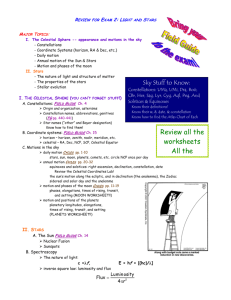DSOinfo
advertisement
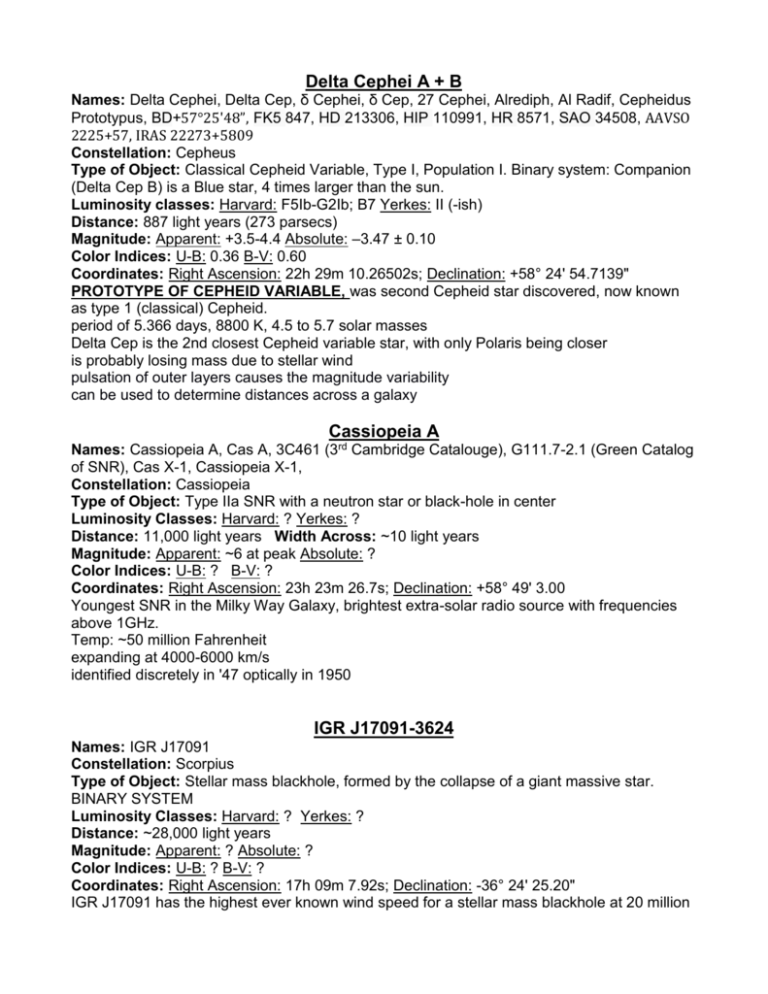
Delta Cephei A + B Names: Delta Cephei, Delta Cep, δ Cephei, δ Cep, 27 Cephei, Alrediph, Al Radif, Cepheidus Prototypus, BD+57°25'48”, FK5 847, HD 213306, HIP 110991, HR 8571, SAO 34508, AAVSO 2225+57, IRAS 22273+5809 Constellation: Cepheus Type of Object: Classical Cepheid Variable, Type I, Population I. Binary system: Companion (Delta Cep B) is a Blue star, 4 times larger than the sun. Luminosity classes: Harvard: F5Ib-G2Ib; B7 Yerkes: II (-ish) Distance: 887 light years (273 parsecs) Magnitude: Apparent: +3.5-4.4 Absolute: –3.47 ± 0.10 Color Indices: U-B: 0.36 B-V: 0.60 Coordinates: Right Ascension: 22h 29m 10.26502s; Declination: +58° 24' 54.7139" PROTOTYPE OF CEPHEID VARIABLE, was second Cepheid star discovered, now known as type 1 (classical) Cepheid. period of 5.366 days, 8800 K, 4.5 to 5.7 solar masses Delta Cep is the 2nd closest Cepheid variable star, with only Polaris being closer is probably losing mass due to stellar wind pulsation of outer layers causes the magnitude variability can be used to determine distances across a galaxy Cassiopeia A Names: Cassiopeia A, Cas A, 3C461 (3rd Cambridge Catalouge), G111.7-2.1 (Green Catalog of SNR), Cas X-1, Cassiopeia X-1, Constellation: Cassiopeia Type of Object: Type IIa SNR with a neutron star or black-hole in center Luminosity Classes: Harvard: ? Yerkes: ? Distance: 11,000 light years Width Across: ~10 light years Magnitude: Apparent: ~6 at peak Absolute: ? Color Indices: U-B: ? B-V: ? Coordinates: Right Ascension: 23h 23m 26.7s; Declination: +58° 49' 3.00 Youngest SNR in the Milky Way Galaxy, brightest extra-solar radio source with frequencies above 1GHz. Temp: ~50 million Fahrenheit expanding at 4000-6000 km/s identified discretely in '47 optically in 1950 IGR J17091-3624 Names: IGR J17091 Constellation: Scorpius Type of Object: Stellar mass blackhole, formed by the collapse of a giant massive star. BINARY SYSTEM Luminosity Classes: Harvard: ? Yerkes: ? Distance: ~28,000 light years Magnitude: Apparent: ? Absolute: ? Color Indices: U-B: ? B-V: ? Coordinates: Right Ascension: 17h 09m 7.92s; Declination: -36° 24' 25.20" IGR J17091 has the highest ever known wind speed for a stellar mass blackhole at 20 million miles per hour, which is only 3% of the speed of light. These winds are about the same speed as other millions or billions times more massive blackholes accretion disc surrounds it, estimates say up to 95% of material in the disc is being ejected due to the wind 5- 10 solar masses one of the smallest blackholes known. very close to stability line X-ray variability--- over 5 to 70 sec periods, similar to GRS 1915+105 but 20 times fainter discovered using ESA's INTEGRAL sat. in April 2003 NGC 6888 Names: WR 136, Crescent Nebula, Caldwell 27, Sharpless 105 Constellation: Cygnus Type of Object: emission nebula Luminosity Classes: Harvard: ? Yerkes: ? Distance: ~5000 light years Magnitude: Apparent: +7.4 Absolute: ? Color Indices: U-B: ? B-V: ? Coordinates: Right Ascension: 20h 12m 35.00s; Declination: +38° 26' 30.00" formed by WR 136, or HD 192163, fast stellar wind colliding with a slower stellar wind from 250,000 yrs ago after becoming a red supergiant 2 shock waves, one inward, one outward. PSR J0108-1431 Names: I don't think there are any others.... Constellation: Cetus Type of Object: pulsar/neutron star, formed from a collapsing star much larger than the sun following a supernova; may have a companion Luminosity Classes: Harvard: ? Yerkes: ? Distance: ~770 light years, nearest pulsar by far Magnitude: Apparent: +27.8 peak Absolute: ? Color Indices: U-B: ? B-V: ? Coordinates: Right Ascension: 01h 08m 08.30s; Declination: -14° 31' 48.50" estimated age appx. 200 million years old, 10x older than the previous oldest X-ray emitter (9 ± 2) × 10^12 W m–2 energy flux slightly more than one rev. per second. as such, very old and faint pulsar PSR J0108-143 has the lowest known dispersion measure at 1.83 pc cm^-3 Has a much higher X-ray reading than expected of an older pulsar. This is probably because the energy being lost as it slows down is being converted to X-ray radiation. More efficient in this process than any other known pulsar. NASA Said: It's likely that two forms of X-ray emission are produced in J0108: emission from particles spiraling around magnetic fields, and emission from heated areas around the neutron star's magnetic poles. Measuring the temperature and size of these heated regions can provide valuable insight into the extraordinary properties of the neutron star surface and the process by which charged particles are accelerated by the pulsar. The younger, bright pulsars commonly detected by radio and X-ray telescopes are not representative of the full population of objects, so observing objects like J0108 helps astronomers see a more complete range of behavior. At its advanced age, J0108 is close to the so- called “pulsar death line,” where its pulsed radiation is expected to switch off and it will become much harder, if not impossible, to observe... ...Currently the pulsar is moving south from the plane of the Milky Way galaxy, but because it is moving more slowly than the escape velocity of the Galaxy, it will eventually curve back towards the plane of the Galaxy in the opposite direction. the pulsar is moving at a velocity of appx 440,000 miles per hour, near normal for pulsars Cygnus X-1 Names: AG (or AGK2)+351910, BD+34 3815,HD (or HDE)226868,HIP 98298, SAO 69181, V1357 Cyg Constellation: Cygnus Type of Object: Stellar mass blackhole with a blue supergiant companion. Never eclipses, almost circular orbit. Luminosity Classes: Harvard: ? Yerkes: ? Distance: ? Width Across: ~700 light years Magnitude: Apparent: +8.95 Absolute: +6.5 Color Indices: U-B: -0.30 B-V: +0.81 Coordinates: Right Ascension: 19h 58m 21.70s; Declination: +35° 12' 05.80" Stephen Hawking lost a bet against Kip Thorne that Cygnus X-1 did not contain a black hole; This black hole is 14.8 times the mass of the sun. appx. 5 million years old? event horizon spinning about 800 times per second. one of the strongest X-ray sources seen from Earth SXP 1062 Names: ? Constellation: Tucana Type of Object: young pulsar found within SNR within the Small Magellanic Cloud (SMC), 1st one Luminosity Classes: Harvard: ? Yerkes: ? Distance: ~180,000 light years Magnitude: Apparent: ? Absolute: ? Color Indices: U-B: ? B-V: ? Coordinates: Right Ascension: 01h 29m 12.40s; Declination: -73° 32' 01.70" lies near a star-forming region shown in the picture on Chandra rotating about once every 18 minutes M-1 Names: Messier Object 1, Crab Nebula, NGC 1952, Taurus A, Sharpless 244 Constellation: Taurus Type of Object: PWN (Pulsar Wind Nebula), also known as a plerion. Luminosity Classes: Harvard: ? Yerkes: ? Distance: ~6500 light years Width Across: ~11 light years, expanding at 1500 km/s Diameter: 28-30 km Neutron Ball Diameter: 12 miles Magnitude: Apparent: +8.4 Absolute: ? Color Indices: U-B: ? B-V: ? Coordinates: Right Ascension: 05h 34m 32s; Declination: +22° 0.0' 52.00" See http://en.wikipedia.org/wiki/Pulsar_wind_nebula for more info First observed in A.D. 1054, the Crab Nebula produces the equivalent of 100,000 suns in Energy and has a pulsar located in its center as well. rotating at 30 times per second electric voltages of ten quadrillion volts because it has magnetized temp.:11,000 and 18,000 K density: 1,300 particles per cm^3 V838 Monocerotis Names: Nova Monocerotis 2002, GSC 04822-00039 Constellation: Monoceros Type of Object: Luminosity Classes: Harvard: ? Yerkes: ? Distance: ~20,000 light years Magnitude: Apparent: +15.74 Absolute: ? Color Indices: U-B: ? B-V: ? Coordinates: Right Ascension: 07h 04m 04.85s; Declination: -03° 50' 50.1" VERY NOTICABLE LIGHT ECHO- when the star’s outer surface brightened, the bright light reflected off of the gas that surrounds the star. as time passes, we see the light reflect further and further away from the star This object became 600,000 times more luminous than our Sun, for an instant, the brightest star in this galaxy, in January of 2002 the star rapidly expanded, yet did not lose its outer layers. It never, therefore, experienced a nova of any kind. instead, the star cooled to nearly the temperature of a light bulb in the on position extreme fluctuations in luminosity, surface temperature some similarities with eruptive variables (changing luminosity) which are unstable highly aged stars. Alpha Orionis Names: Betelgeuse, α Ori, 58 Ori, HR 2061, BD +7° 1055, HD 39801, FK5224, HIP 27989, SAO 113271, GC 7451, CCDM J05552+0724AP, AAVSO 0549+07 Constellation: Orion Type of Object: Red Supergiant that will explode as a type II SN within a million years. (SRC) Luminosity Classes: Harvard: M2 Yerkes: Iab Distance: ~643 light years Magnitude: Apparent: +0.2 to +1.2 (widest range of any 1st magnitude star) Absolute: -6 Color Indices: U-B: ? B-V: ? Coordinates: Right Ascension: 05h 55m 10.3053s; Declination: +07° 24' 25.426" 8th brightest star in night sky, one of the largest and most luminous observable stars Star is moving at 30 km/s rapidly evolved, only 10 million years old, due to high mass. obscured by a complex, asymmetric envelope ~250 times the size of the star, caused by colossal mass loss. SN 2010JL Names: ? Constellation: Leo Type of Object: SNR Luminosity Classes: Harvard: ? Yerkes: ? Distance: ~160 million light years Magnitude: Apparent: ? Absolute: ? Color Indices: U-B: ? B-V: ? Coordinates: Right Ascension: 09h 42m 53.33s; Declination: +09° 29' 41.80" \ It is the first evidence in X-rays of a supernova shock wave breaking through a cocoon of gas around the star. This discovery may help explain why some supernova explosions are more powerful than others. SN 2010JL was first spotted by astronomers on November 3, 2010, and probably exploded about a month before that. 10 times more luminous than normal SN due to massive star collapsing gases emitting X-rays detected from this SN are over 100 million Kelvin NGC 3582 Names: ? Constellation: Carina Type of Object: Stellar nursery/Nebula located in RCW 57 Luminosity Classes: Harvard: ? Yerkes: ? Distance: ~6000 light years Magnitude: Apparent: ? Absolute: ? Color Indices: U-B: ? B-V: ? Coordinates: Right Ascension: ? Declination: ? “33 massive stars in the end stages of formation, and the clear presence of the complex carbon molecules known as polycyclic aromatic hydrocarbons (PAHs). PAHs are thought to be created in the cooling gas of star forming regions, and their development in the Sun's formation nebula five billion years ago may have been an important step in the development of life on Earth “ “These loops are thought to have been ejected by dying stars, but new stars are also being born within this stellar nursery. These energetic youngsters emit intense ultraviolet radiation that makes the gas in the nebula glow, producing the fiery display shown here. “ Some stars in this region are much larger than the Sun, many of these stars live very short lives and end as Supernovae only visible from observers in the southern hemisphere LHa115-N19 Names: N19, Constellation: Tucana, in the Small Magellanic Cloud, dwarf Galaxy near ours. Type of Object: ? Luminosity Classes: Harvard: ? Yerkes: ? Distance: ~196,000 light years Magnitude: Apparent: ? Absolute: ? Color Indices: U-B: ? B-V: ? Coordinates: Right Ascension: 0h 47m 31s; Declination: -73° 8.3' This area is filled with ionized hydrogen gas and it is where many massive stars are expelling dust and gas through stellar winds. “The Chandra data show evidence for three supernova explosions in this relatively small region. Furthermore, the Chandra observations suggest that each of these supernova remnants were caused by a similar process: the collapse of a very massive star. There are hints that these stars were members of a so-called OB association, a group of stars that formed from the same interstellar cloud. “ “The superbubble spied by Williams and her colleagues is coming together in a region of the Small Magellanic Cloud known as LHa115-N19 (N19), an area rich with ionized hydrogen gas and populated by massive stars blowing out their own dust and gas in stellar winds [image]. Supernova remnants, vast gas shells belched out during a star's explosive demise, also appear in the region, “ Super bubble being formed as a result of stellar winds, Supernovae Antares Names: Alpha Scorpii, α Scorpii, 21 Sco, Cor Scorpii, Kalb al Akrab, Scorpion's Heart, Vespertilio, HR 6134, CD-26°11359, HD148478, SAO 184415, FK5 616, WDS 16294-2626, CCDM J16294-2626A/B, HIP80763 Constellation: Scorpius Type of Object: Red Supergiant Luminosity Classes: Harvard: M1.5 Yerkes: Iab-b Distance: ~550 light years Magnitude: Apparent: 0.96 Absolute: -5.28 Color Indices: U-B: +1.34 B-V: +1.83 Coordinates: Right Ascension: 16h 29m 24.45970s; Declination: -26° 25' 55.2094 in the Milky Way galaxy and the sixteenth brightest star in the nighttime sky. has a radius of approximately 883 times that of the Sun, 15-18 solar masses Has a companion, Antares B, about 530 AU away. Often seen as green. Rho Ophiuchi Cloud Complex Names: Ophiuchus molecular cloud, Integral 691, XSS J16271-2423 Constellation: Ophiuchus Type of Object: Luminosity Classes: Harvard: ? Yerkes: ? Distance: ~460 light years Magnitude: Apparent: ? Absolute: ? Color Indices: U-B: ? B-V: ? Coordinates: Right Ascension: ? Declination: ? One of the closest star-forming regions. Right Ascension: 16h 28m 06s; Declination: -24° 32.5′ dark nebula, south of star Rho Ophiuci total of 3000 times the mass of the Sun. Over half of the mass of the complex is concentrated around the L1688 cloud, and this is the most active star-forming region One of the older objects at the edge of the primary star-forming region was found to be a circumstellar disk seen nearly edge on. It spans a diameter of 300 AU and contains at least twice the mass of Jupiter. The million-year-old star at the center of the disk has a temperature of 3,000 K and is emitting 0.4 times the luminosity of the Sun. 16 classified as protostars, 123 T-Tauri Stars with dense circumstellar masses and 77 weaker T-Tauri stars with thinner disks The last two categories of stars have estimated ages ranging from 100,000 to a million years IC 1396 Names: Elephant's Trunk nebula Constellation: Cepheus Type of Object: One of largest emission nebulae in night sky, dark nebula Luminosity Classes: Harvard: ? Yerkes: ? Distance: ~2400 light years Magnitude: Apparent: ? Absolute: ? Color Indices: U-B: ? B-V: ? Coordinates: Right Ascension: 21h 38m 8.7s; Declination: +57° 26' 48" It contains "the Elephant's Trunk", a dark, dense globule in the nebula. It is illuminated by the massive O-type star HD 206267 in the center. Radiation and winds from this hot star are thought to compress parts of the cloud and trigger star formation. contains several very young (less than 100,000 yr) stars that were discovered in infrared images in 2003. Two older (but still young, a couple of million years, by the standards of stars, which live for billions of years) stars are present in a small, circular cavity in the head of the globule. Winds from these young stars may have emptied the cavity.
